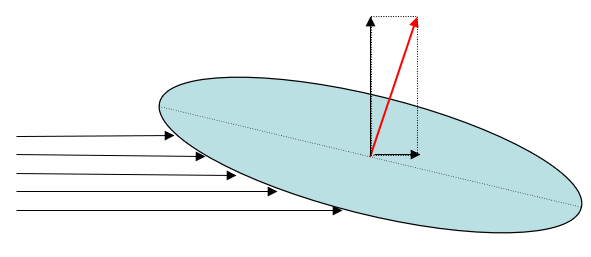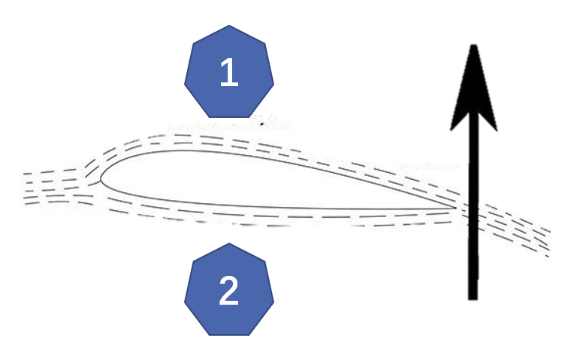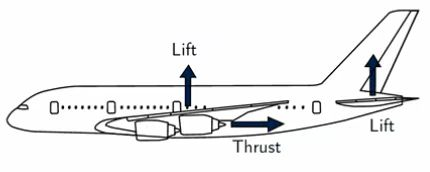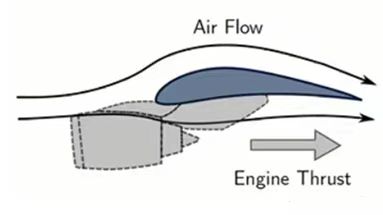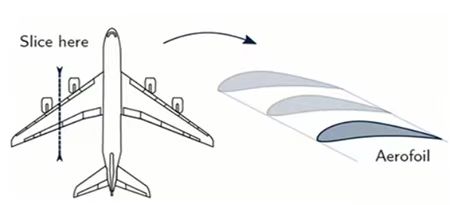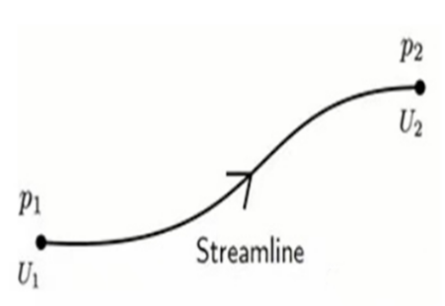1. Introduction
The airplane is one of the greatest inventions of the twentieth century. In modern society, due to the rapid development of science and technology (fluid mechanics, automatic control systems, etc.), aircraft have become a basic means of transportation. This paper is used to popularize the principle of aircraft takeoff and the role of some parts in the flight process, from the perspective of how the aircraft generates lift, accurate to the role of parts such as wings and flaps, so as to understand the principle of aircraft liftoff.
2. The basic principle of aircraft liftoff
The flight of the aircraft should solve two problems: one is to rise. The second is to move forward. Forward motion depends on the forward traction generated by the power of the engine driving the propeller rotation or the forward thrust generated by the jet. The rise is based on Bernoulli's principle, which states that the greater the flow velocity of the fluid (including air flow and water flow), the smaller its pressure. The smaller the flow rate, the greater the pressure. In addition to the flow rate, aircraft liftoff has a lot to do with lift and angle of attack.
Bernoulli's equation was proposed by Daniel Bernoulli in 1726 when he studied the stable flow of ideal liquids[1]. Static pressure is the real pressure value of a fluid, and dynamic pressure is also called speed pressure or velocity head, and its unit is Pa. Dynamic pressure plays a role in adjusting the proportion of static pressure in the total pressure: the greater the dynamic pressure, the smaller the static pressure; The smaller the dynamic pressure, the greater the static pressure; When the dynamic pressure is zero, that is, when the flow rate is zero, the static pressure is at its maximum and equal to the total pressure value. Therefore, the physical meaning of Bernoulli's equation can also be said to mean that the compressive energy and kinetic energy of a fluid can be converted into each other, but the total mechanical energy of the flow remains unchanged. The Bernoulli equation is the basic equation of fluid mechanics, which reflects the relationship between pressure, velocity and altitude when an ideal liquid flows steadily.
Aircraft wings are generally curved on the top and flat on the bottom. During the flight of the aircraft, the wing cuts the head-on wind into the upper and lower parts. In the same time, the air flow through the upper and lower surfaces of the wing has the same displacement, but through different paths. The air flow through the upper surface of the wing has a long path, so the velocity is fast. On the lower surface, the air has a short distance to travel, so the velocity is slow. According to Bernoulli's principle, static pressure is low at high velocity and high at low velocity. This creates an upward pressure difference between the upper and lower surfaces of the wings, so the plane can take off and fly against gravity.In fact, this principle is not only used in aircraft, but also in various fields.
Figure 1 shows the force model of the aircraft taking off.
|
Figure 1. Imagine aircraft plane. |
\( Σ{F_{x}}=m{({a_{G}})_{x}}\ \ \ (1) \)
\( Σ{F_{y}}=m{({a_{G}})_{y}}\ \ \ (2) \)
\( Σ{M_{p}}=Σ{({M_{k}})_{p}}\ \ \ (3) \)
This plane is subjected to a horizontal air flow force, which creates a supporting force in the upper right direction. The vertical component of the support force is lift. According to this theory, we can get a reference.
According to this theory, Bernoulli's equation is applicable to the take-off process of aircraft.
To deal with the aircraft problem using the Bernoulli equation, we take a part of the aircraft (as shown below):
|
Figure 2. Pressure differences picture. |
\( \ \ \ (4) \)
(Bernoulli formula)
Figure 2 shows the different speeds of the upper and lower surfaces of the wings as the plane flies. The top surface is velocity 1, and the bottom surface is velocity 2 First of all, due to the high flight altitude of the aircraft, the difference between the upper and lower surfaces above the ground can be ignored. Then, the air flight time is the same, but the air above the wing flies a long distance due to the bulge, so the velocity 1 above is faster than the velocity 2 below. Therefore, if the pressure above is less than the pressure below, a pressure difference will be generated, and a vertical lift will be generated.
So, a problem arises. If you keep flying up, the plane is a rocket, but it's not. The reason for this is that when a certain cycle speed is reached, the aircraft can fly at high altitudes. Calculations are needed to determine the streamlines of the linear velocity and the energy required to achieve this lift.
3. Analysis of important parts and components during aircraft takeoff
3.1. The role of the wing:
The wing is the part of the aircraft that generates lift. Its area, plane shape, airfoil shape and the configuration of components on the wing not only directly affect the performance of the aircraft, but also have a certain impact on the structural arrangement, weight and life of the wing [2].
Similarly, wing shapes have many applications in life, such as airplane wings, spoilers in racing cars, turbine blades, and so on. The engine propels the plane forward, and it's actually the wings that generate all the upward lift, allowing the plane to lift into the sky.
As can be seen from Figure 3, the wing of an aircraft is made up of several sets of wings. As the figure 4, engine pushes the wing and the aircraft forward, air sweeps over the surface of the wing, creating lift for the aircraft.
|
| |
Figure 3. Schematic diagram of aircraft forces [3]. | Figure 4. Diagram of engine operation [3]. | |
|
| |
Figure 5. Diagram of engine operation [3]. | Figure 6. Diagram of air movement [3]. |
Figure 5 shows the exact position of the wing on a normal commercial aircraft.
The essential reason for the lift generated by the wing can be explained by the Bernoulli equation: when the fluid moves from point 1 to point 2, if the flow accelerates, the static pressure at point 2 must drop. Conversely, if the fluid velocity slows down, the static pressure at point 2 must rise.
According to Figure 6, wings function by changing the velocity of fluid around them by changing their shape. According to Bernoulli's formula, a change in speed causes a change in pressure around the wing. These pressures act on and perpendicular to the wing surface, and are the combined force of these pressures is lift, lifting the wing and aircraft off the ground.
3.2. The role of the flap
Through the previous introduction, we learned that the reason why the aircraft can take off is because the wings generate lift. But in most cases, we need different speeds to meet different needs. There are two ways to change the flight speed: bending the wing and increasing the wing area. Then the flaps appeared. Flaps are movable flaps attached to the leading or trailing edge of a wing. Flaps have many very important functions. It can change the cross-sectional shape of the wing, increase the curvature of the wing. It is possible to increase the area of the wing and the flaps keep the airflow as laminar as possible.
The following mainly describes the three types of flaps.
3.2.1. Fuller flaps. The fuller flap is a relatively complete trailing edge flap type. It can be seen as a deformation of the slit flap, the thickness of the flap is thinned, and the length of the thinning is the length of the rear edge of the wing extending backwards. The use of fuller flaps can increase the curvature of the wing profile, and at the same time can greatly increase the wing area, and the effect of increasing lift is very obvious. One of the disadvantages of fuller flaps is their complex structure[7]. But the Fuller flap is still the most widely used one.
3.2.2. Kruger flaps. The Kruger flap is located on the leading edge of the wing and has a more complex structure than the leading edge flap. The concept of Kruger flaps was first proposed by Krueger in 1947. In 1970, Boeing achieved the variable curvature Kruger design with a four-hinge mechanism, but it was discontinued due to the complexity of the design and the extremely cumbersome manufacturing and maintenance costs. Since then, development of Kruger flaps has essentially stalled until the emergence of new requirements for lifting devices for future civilian aircraft, such as laminar flow technology and BWB layout, and research on Kruger flaps has gradually awakened[8]. Mainly used in supersonic aircraft. When in use, the Kruger flaps extend forward and downward, not only changing the wing shape, but also increasing the area of the wing. Therefore, the lift effect is also better.
3.2.3. Open-seam flaps. Open-seam flaps are mainly used for leading edge slats. There are three main types of leading edge slats: fixed slats, and after introducing slats, high-speed airflow from the lower surface of the wing passes through the slats. The boundary layer separation between the slats and the main wing is greatly suppressed, and the stall angle of attack and maximum lift are increased. The wing structure of the leading edge slit wing has a good form of stress, and the material can be easily fully utilized; Secondly, the operating system of the leading edge slit wing is simpler and lighter[9].
4. Influencing factors during the flight of the extension
4.1. Frictional resistance and differential pressure
4.1.1. Air viscosity. When the aircraft is flying in the air, it will rub against the air, creating frictional resistance. Air is a kind of fluid, and air viscosity is one of its physical properties (the viscosity force inside the fluid is proportional to the gradient of the velocity between different flow layers, and the scaling coefficient is called kinetic viscosity, or simply the viscosity coefficient). Air is a fluid and therefore viscous[10]. The speed of an aircraft in the air is affected by the viscosity of the air.
4.1.2. Contact area. However, the size of the frictional resistance of aircraft flight depends not only on the viscosity of the air but also on the size of the contact surface area between the air and the aircraft, the rougher the surface of the aircraft and the larger the surface area of the air. The greater the frictional resistance of the aircraft. Conversely, the smoother the surface of the aircraft, the smaller the surface area of the air in contact with the aircraft, and the less friction is generated.
4.1.3. Airflow boundary layer. Near the solid wall, due to the influence of the solid boundary, there is a fluid layer with a large velocity gradient, called the flow boundary layer. On the other hand, if the boundary layer on the surface of the object is a laminar boundary layer, the frictional resistance caused by air viscosity is relatively small. If the boundary layer on the surface of the object is a turbulent boundary layer, the frictional resistance caused by air viscosity is relatively large.
4.2. Induced resistance and interference resistance
4.2.1. Induce resistance. Inducing resistance refers to the drag at the toe of the machine (such as the wing tip, tail tip part). The air from the lower wing surface with low flow velocity and high static pressure flows around the wingtip to the upper wing surface with high flow velocity and low static pressure, thus forming a vortex at the wing tip. It changes the direction of the airflow above the wing close to the wingtip, creating a drag known as “induced drag”.
4.2.2. Interference resistance. Interference resistance is the additional drag created by the interaction between aircraft components. This drag tends to occur between the fuselage and wing, the fuselage and the tail, the wing and the engine nacelle, and the wing and the airdrop tank.
A similar vortex disturbance can be described as goose flying. When the wild goose zigzags and flies, the wings that follow it are in the tip vortex formed by the front wing, providing lift. Wake disturbance is when any object protruding from the surface of an aircraft can create differential pressure drag, which is created by the wake. The last type is pressure disturbance, which refers to the resistance caused by uneven air pressure on the surface.
5. Conclusion
This paper briefly introduces the principle of modern aircraft takeoff, as well as the basic functions of wings and flaps, and briefly analyzes the force of aircraft during takeoff. According to Bernoulli's principle, aircraft wings are used to provide lift, due to the special shape of the wing, the flow rate difference between the upper and lower surfaces of the wing when the air flow passes through, and the lower surface flow velocity is greater than the upper surface to produce an upward pressure difference, so an upward lift is generated. How to adjust the flight angle and flight speed of the aircraft also depends on the flaps, which generally adjust the flight parts by changing the force area and force angle, which are classified as Kruger flaps, slit flaps and fuller flaps. Other factors influencing aircraft flight include frictional drag, air viscosity, induced drag, and interference resistance. However, due to limited access to the data, no more sophisticated analysis was carried out, and no relevant calculations were conducted. The article is limited and can only briefly reflect the flight principle of the aircraft and the related functions of each component. The flight characteristics of different types of aircraft will continue to be studied in the future.
References
[1]. Bi Xiaolin, "Bernoulli's principle and its applications," Secondary School Physics Teaching Reference, pp. 1-3, 3 2020
[2]. Shan Yongfei and Liu Linhai, "The Effect of Wing Plane Shape on Structural Weight of a Domestic Pre-developed Aircraft," 15 March 2001. Available:https://kns.cnki.net/kcms/detail/detail.aspx?dbcode=CJFD&dbname=CJFD2001&filename=MYFJ200101001&uniplatform=NZKPT&v=antxNfs_HaUTsM-93a_ YSAqCy8Pf8ijeFU-GVA_HAujE2USUGWRmeWKHDdWY7BEi.
[3]. BB senior, "Zhihu," Zhihu, Available: https://zhuanlan.zhihu.com/p/402446480. [Date of visit: 22 November 2022]
[4]. Wei Wei, Yuanqing Zhang, Rui He, Weijun Cui, "Research on Trailing Edge Flaps Motion Design of Large Civil Aircraft," Science and Technology Vision, 9 2018
[5]. Zhang Minghui, Chen Zhenli, Mao Jun, Wang Gang, Tan Zhaoguang, Wang Long, Zhang Binqian, "Wing-body fusion layout civil aircraft Kruger flap design," Aeronautics and Astronautical Journal, pp. 1-3, 25 9 2019
[6]. Xuebo Yao, "Design Analysis of Leading Edge Slatted Wing Structure," 15 Dec 1996. Available:https://kns.cnki.net/kcms/detail/detail.aspx?dbcode=CJFD&dbname=CJFD9697&filename=MYFJ199604004&uniplatform=NZKPT&v=14-W7V4yAYEZoIOdVHphEuBsWDpYDfFRTEN_73NUSBIu8lDBc1uAyj1oLVSH5C5d.
[7]. Guo Ma, Chao Li, Zhenpeng Zhu, Ziyu Liu, Junwen Huang, Aoyun Zhang, "Measuring Air Using Hall Elements Based on Pendulum Experiments," University Physics Experiments, 26 Apr, 2022.
Cite this article
Zhu,C. (2023). Research on the Principle of Aircraft Take-off and the Functions of Its Parts. Theoretical and Natural Science,5,299-304.
Data availability
The datasets used and/or analyzed during the current study will be available from the authors upon reasonable request.
Disclaimer/Publisher's Note
The statements, opinions and data contained in all publications are solely those of the individual author(s) and contributor(s) and not of EWA Publishing and/or the editor(s). EWA Publishing and/or the editor(s) disclaim responsibility for any injury to people or property resulting from any ideas, methods, instructions or products referred to in the content.
About volume
Volume title: Proceedings of the 2nd International Conference on Computing Innovation and Applied Physics (CONF-CIAP 2023)
© 2024 by the author(s). Licensee EWA Publishing, Oxford, UK. This article is an open access article distributed under the terms and
conditions of the Creative Commons Attribution (CC BY) license. Authors who
publish this series agree to the following terms:
1. Authors retain copyright and grant the series right of first publication with the work simultaneously licensed under a Creative Commons
Attribution License that allows others to share the work with an acknowledgment of the work's authorship and initial publication in this
series.
2. Authors are able to enter into separate, additional contractual arrangements for the non-exclusive distribution of the series's published
version of the work (e.g., post it to an institutional repository or publish it in a book), with an acknowledgment of its initial
publication in this series.
3. Authors are permitted and encouraged to post their work online (e.g., in institutional repositories or on their website) prior to and
during the submission process, as it can lead to productive exchanges, as well as earlier and greater citation of published work (See
Open access policy for details).
References
[1]. Bi Xiaolin, "Bernoulli's principle and its applications," Secondary School Physics Teaching Reference, pp. 1-3, 3 2020
[2]. Shan Yongfei and Liu Linhai, "The Effect of Wing Plane Shape on Structural Weight of a Domestic Pre-developed Aircraft," 15 March 2001. Available:https://kns.cnki.net/kcms/detail/detail.aspx?dbcode=CJFD&dbname=CJFD2001&filename=MYFJ200101001&uniplatform=NZKPT&v=antxNfs_HaUTsM-93a_ YSAqCy8Pf8ijeFU-GVA_HAujE2USUGWRmeWKHDdWY7BEi.
[3]. BB senior, "Zhihu," Zhihu, Available: https://zhuanlan.zhihu.com/p/402446480. [Date of visit: 22 November 2022]
[4]. Wei Wei, Yuanqing Zhang, Rui He, Weijun Cui, "Research on Trailing Edge Flaps Motion Design of Large Civil Aircraft," Science and Technology Vision, 9 2018
[5]. Zhang Minghui, Chen Zhenli, Mao Jun, Wang Gang, Tan Zhaoguang, Wang Long, Zhang Binqian, "Wing-body fusion layout civil aircraft Kruger flap design," Aeronautics and Astronautical Journal, pp. 1-3, 25 9 2019
[6]. Xuebo Yao, "Design Analysis of Leading Edge Slatted Wing Structure," 15 Dec 1996. Available:https://kns.cnki.net/kcms/detail/detail.aspx?dbcode=CJFD&dbname=CJFD9697&filename=MYFJ199604004&uniplatform=NZKPT&v=14-W7V4yAYEZoIOdVHphEuBsWDpYDfFRTEN_73NUSBIu8lDBc1uAyj1oLVSH5C5d.
[7]. Guo Ma, Chao Li, Zhenpeng Zhu, Ziyu Liu, Junwen Huang, Aoyun Zhang, "Measuring Air Using Hall Elements Based on Pendulum Experiments," University Physics Experiments, 26 Apr, 2022.










